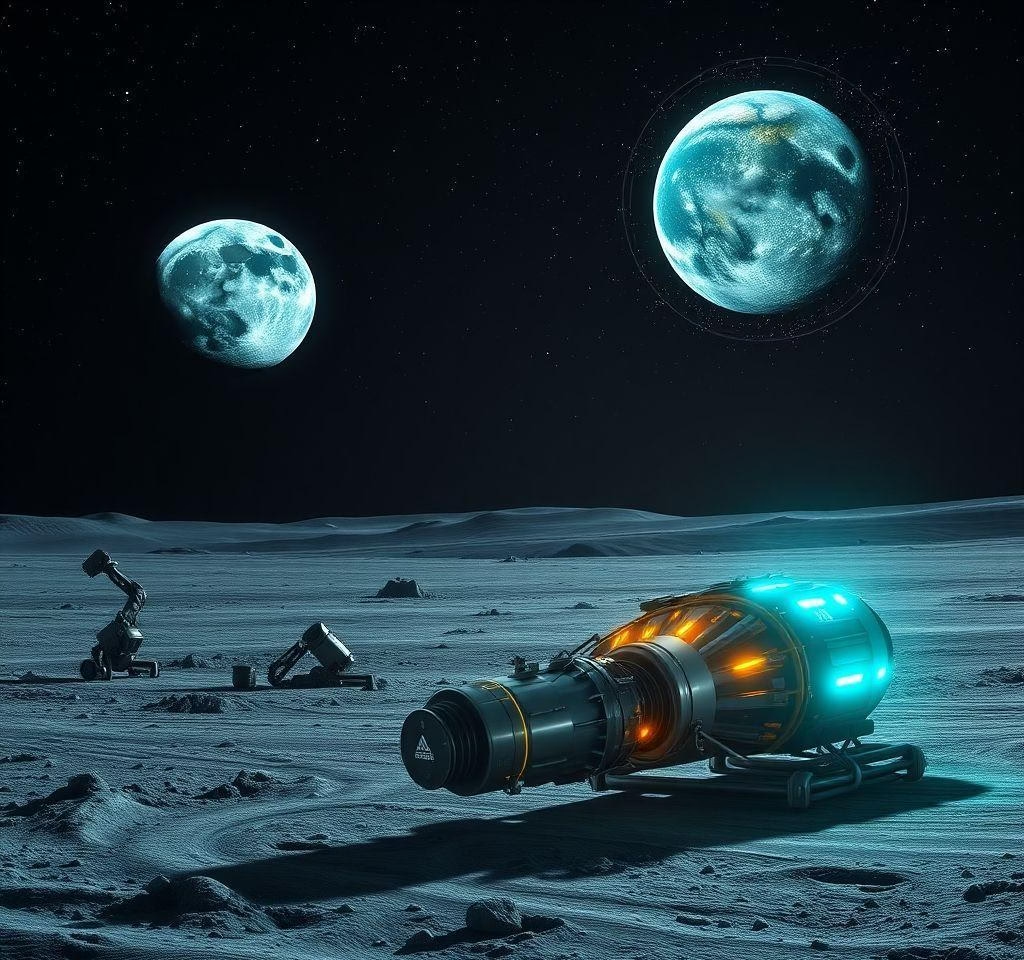The Pioneering Role of AI in Modern Space Exploration
From guiding rovers on Mars to managing billion-dollar telescopes, artificial intelligence has become indispensable to modern space exploration. This article examines how machine learning algorithms are redefining mission parameters, data interpretation, and the very boundaries of human spaceflight capability.
The Emergence of AI in Space Technology
The Emergence of AI in Space Technology
The integration of artificial intelligence (AI) in space missions marks a pivotal shift in space exploration. Early probes relied on pre-programmed instructions. These reactive systems lacked adaptability. Later missions saw the introduction of more sophisticated AI. This allowed for autonomous navigation and decision-making. The shift from reactive to predictive AI is evident. This is observable in current Mars rovers. These rovers utilize AI for path planning and hazard avoidance. NASA and ESA missions increasingly rely on machine learning algorithms. These algorithms enable faster data analysis and anomaly detection. AI’s predictive capabilities empower more efficient resource management. Furthermore, AI facilitates autonomous operations in extreme environments. This reduces the need for constant human intervention. AI’s expanding role is instrumental in furthering the capabilities and scope of space exploration. The future promises more profound AI integration in space-related endeavors. This will usher in a new era of discovery and understanding.
AI-Driven Data Analysis in Deep-Space Exploration
The Emergence of AI in Space Technology
The integration of artificial intelligence (AI) in space missions marks a pivotal shift in space exploration. Early probes relied on pre-programmed instructions. These reactive systems lacked adaptability. Later missions saw the introduction of more sophisticated AI. This allowed for autonomous navigation and decision-making. The shift from reactive to predictive AI is evident. This is observable in current Mars rovers. These rovers utilize AI for path planning and hazard avoidance. NASA and ESA missions increasingly rely on machine learning algorithms. These algorithms enable faster data analysis and anomaly detection. AI’s predictive capabilities empower more efficient resource management. Furthermore, AI facilitates autonomous operations in extreme environments. This reduces the need for constant human intervention. AI’s expanding role is instrumental in furthering the capabilities and scope of space exploration. The future promises more profound AI integration in space-related endeavors. This will usher in a new era of discovery and understanding.
Autonomous Systems for Unmanned Missions
The Emergence of AI in Space Technology
The integration of artificial intelligence (AI) in space missions marks a pivotal shift in space exploration. Early probes relied on pre-programmed instructions. These reactive systems lacked adaptability. Later missions saw the introduction of more sophisticated AI. This allowed for autonomous navigation and decision-making. The shift from reactive to predictive AI is evident. This is observable in current Mars rovers. These rovers utilize AI for path planning and hazard avoidance. NASA and ESA missions increasingly rely on machine learning algorithms. These algorithms enable faster data analysis and anomaly detection. AI’s predictive capabilities empower more efficient resource management. Furthermore, AI facilitates autonomous operations in extreme environments. This reduces the need for constant human intervention. AI’s expanding role is instrumental in furthering the capabilities and scope of space exploration. The future promises more profound AI integration in space-related endeavors. This will usher in a new era of discovery and understanding.
Ethical Considerations and Future Risks
The Emergence of AI in Space Technology
The integration of artificial intelligence (AI) in space missions marks a pivotal shift in space exploration. Early probes relied on pre-programmed instructions. These reactive systems lacked adaptability. Later missions saw the introduction of more sophisticated AI. This allowed for autonomous navigation and decision-making. The shift from reactive to predictive AI is evident. This is observable in current Mars rovers. These rovers utilize AI for path planning and hazard avoidance. NASA and ESA missions increasingly rely on machine learning algorithms. These algorithms enable faster data analysis and anomaly detection. AI’s predictive capabilities empower more efficient resource management. Furthermore, AI facilitates autonomous operations in extreme environments. This reduces the need for constant human intervention. AI’s expanding role is instrumental in furthering the capabilities and scope of space exploration. The future promises more profound AI integration in space-related endeavors. This will usher in a new era of discovery and understanding.
The Roadmap to AI-Powered Interstellar Travel
The Emergence of AI in Space Technology
The integration of artificial intelligence (AI) in space missions marks a pivotal shift in space exploration. Early probes relied on pre-programmed instructions. These reactive systems lacked adaptability. Later missions saw the introduction of more sophisticated AI. This allowed for autonomous navigation and decision-making. The shift from reactive to predictive AI is evident. This is observable in current Mars rovers. These rovers utilize AI for path planning and hazard avoidance. NASA and ESA missions increasingly rely on machine learning algorithms. These algorithms enable faster data analysis and anomaly detection. AI’s predictive capabilities empower more efficient resource management. Furthermore, AI facilitates autonomous operations in extreme environments. This reduces the need for constant human intervention. AI’s expanding role is instrumental in furthering the capabilities and scope of space exploration. The future promises more profound AI integration in space-related endeavors. This will usher in a new era of discovery and understanding.
The Emergence of AI in Space Technology
AI-Driven Data Analysis in Deep-Space Exploration
The sheer volume of data generated by deep-space missions presents significant challenges. Machine learning algorithms are crucial for processing petabytes of telemetry data. This data comes from telescopes, satellites, and landers. These algorithms enable efficient data analysis and pattern recognition.
Anomaly detection is a key application. For example, in the analysis of data from a large space telescope, AI can identify unusual readings. This alerts scientists to potential instrument malfunctions. Similarly, AI aids in the analysis of Martian soil samples. Convolutional neural networks process images. This helps scientists to identify various minerals and compounds.
AI also enhances the speed and accuracy of data analysis. This allows scientists to focus on interpreting results. Machine learning contributes to a better understanding of celestial bodies. Predictive models can assist in mission planning. Autonomous systems rely on AI for real-time decision making. The efficiency and effectiveness of space exploration benefit immensely from the use of AI.
AI-Driven Data Analysis in Deep-Space Exploration
AI-Driven Data Analysis in Deep-Space Exploration
The sheer volume of data generated by deep-space missions presents significant challenges. Machine learning algorithms are crucial for processing petabytes of telemetry data. This data comes from telescopes, satellites, and landers. These algorithms enable efficient data analysis and pattern recognition.
Anomaly detection is a key application. For example, in the analysis of data from a large space telescope, AI can identify unusual readings. This alerts scientists to potential instrument malfunctions. Similarly, AI aids in the analysis of Martian soil samples. Convolutional neural networks process images. This helps scientists to identify various minerals and compounds.
AI also enhances the speed and accuracy of data analysis. This allows scientists to focus on interpreting results. Machine learning contributes to a better understanding of celestial bodies. Predictive models can assist in mission planning. Autonomous systems rely on AI for real-time decision making. The efficiency and effectiveness of space exploration benefit immensely from the use of AI.
Autonomous Systems for Unmanned Missions
AI-Driven Data Analysis in Deep-Space Exploration
The sheer volume of data generated by deep-space missions presents significant challenges. Machine learning algorithms are crucial for processing petabytes of telemetry data. This data comes from telescopes, satellites, and landers. These algorithms enable efficient data analysis and pattern recognition.
Anomaly detection is a key application. For example, in the analysis of data from a large space telescope, AI can identify unusual readings. This alerts scientists to potential instrument malfunctions. Similarly, AI aids in the analysis of Martian soil samples. Convolutional neural networks process images. This helps scientists to identify various minerals and compounds.
AI also enhances the speed and accuracy of data analysis. This allows scientists to focus on interpreting results. Machine learning contributes to a better understanding of celestial bodies. Predictive models can assist in mission planning. Autonomous systems rely on AI for real-time decision making. The efficiency and effectiveness of space exploration benefit immensely from the use of AI.
Ethical Considerations and Future Risks
AI-Driven Data Analysis in Deep-Space Exploration
The sheer volume of data generated by deep-space missions presents significant challenges. Machine learning algorithms are crucial for processing petabytes of telemetry data. This data comes from telescopes, satellites, and landers. These algorithms enable efficient data analysis and pattern recognition.
Anomaly detection is a key application. For example, in the analysis of data from a large space telescope, AI can identify unusual readings. This alerts scientists to potential instrument malfunctions. Similarly, AI aids in the analysis of Martian soil samples. Convolutional neural networks process images. This helps scientists to identify various minerals and compounds.
AI also enhances the speed and accuracy of data analysis. This allows scientists to focus on interpreting results. Machine learning contributes to a better understanding of celestial bodies. Predictive models can assist in mission planning. Autonomous systems rely on AI for real-time decision making. The efficiency and effectiveness of space exploration benefit immensely from the use of AI.
The Roadmap to AI-Powered Interstellar Travel
AI-Driven Data Analysis in Deep-Space Exploration
The sheer volume of data generated by deep-space missions presents significant challenges. Machine learning algorithms are crucial for processing petabytes of telemetry data. This data comes from telescopes, satellites, and landers. These algorithms enable efficient data analysis and pattern recognition.
Anomaly detection is a key application. For example, in the analysis of data from a large space telescope, AI can identify unusual readings. This alerts scientists to potential instrument malfunctions. Similarly, AI aids in the analysis of Martian soil samples. Convolutional neural networks process images. This helps scientists to identify various minerals and compounds.
AI also enhances the speed and accuracy of data analysis. This allows scientists to focus on interpreting results. Machine learning contributes to a better understanding of celestial bodies. Predictive models can assist in mission planning. Autonomous systems rely on AI for real-time decision making. The efficiency and effectiveness of space exploration benefit immensely from the use of AI.
The Emergence of AI in Space Technology
Autonomous Systems for Unmanned Missions
The increasing sophistication of AI is enabling truly autonomous space missions. This reduces reliance on Earth-based commands, crucial for missions to distant locations like Europa or during asteroid mining operations. Autonomous rover navigation systems allow for exploration of challenging terrains. These systems utilize advanced sensors and AI algorithms for path planning and obstacle avoidance.
AI-piloted satellite swarms are another example. These swarms allow for coordinated observation and data collection. This is more efficient than individual satellites. Real-time decision-making systems are vital for asteroid mining. These systems adapt to unpredictable situations, optimizing resource extraction. AI algorithms ensure safe and efficient operations, minimizing risk and maximizing productivity. These autonomous capabilities are transformative. They extend our reach across the cosmos and unlock new possibilities in space exploration.
AI-Driven Data Analysis in Deep-Space Exploration
Autonomous Systems for Unmanned Missions
The increasing sophistication of AI is enabling truly autonomous space missions. This reduces reliance on Earth-based commands, crucial for missions to distant locations like Europa or during asteroid mining operations. Autonomous rover navigation systems allow for exploration of challenging terrains. These systems utilize advanced sensors and AI algorithms for path planning and obstacle avoidance.
AI-piloted satellite swarms are another example. These swarms allow for coordinated observation and data collection. This is more efficient than individual satellites. Real-time decision-making systems are vital for asteroid mining. These systems adapt to unpredictable situations, optimizing resource extraction. AI algorithms ensure safe and efficient operations, minimizing risk and maximizing productivity. These autonomous capabilities are transformative. They extend our reach across the cosmos and unlock new possibilities in space exploration.
Autonomous Systems for Unmanned Missions
Autonomous Systems for Unmanned Missions
The increasing sophistication of AI is enabling truly autonomous space missions. This reduces reliance on Earth-based commands, crucial for missions to distant locations like Europa or during asteroid mining operations. Autonomous rover navigation systems allow for exploration of challenging terrains. These systems utilize advanced sensors and AI algorithms for path planning and obstacle avoidance.
AI-piloted satellite swarms are another example. These swarms allow for coordinated observation and data collection. This is more efficient than individual satellites. Real-time decision-making systems are vital for asteroid mining. These systems adapt to unpredictable situations, optimizing resource extraction. AI algorithms ensure safe and efficient operations, minimizing risk and maximizing productivity. These autonomous capabilities are transformative. They extend our reach across the cosmos and unlock new possibilities in space exploration.
Ethical Considerations and Future Risks
Autonomous Systems for Unmanned Missions
The increasing sophistication of AI is enabling truly autonomous space missions. This reduces reliance on Earth-based commands, crucial for missions to distant locations like Europa or during asteroid mining operations. Autonomous rover navigation systems allow for exploration of challenging terrains. These systems utilize advanced sensors and AI algorithms for path planning and obstacle avoidance.
AI-piloted satellite swarms are another example. These swarms allow for coordinated observation and data collection. This is more efficient than individual satellites. Real-time decision-making systems are vital for asteroid mining. These systems adapt to unpredictable situations, optimizing resource extraction. AI algorithms ensure safe and efficient operations, minimizing risk and maximizing productivity. These autonomous capabilities are transformative. They extend our reach across the cosmos and unlock new possibilities in space exploration.
The Roadmap to AI-Powered Interstellar Travel
Autonomous Systems for Unmanned Missions
The increasing sophistication of AI is enabling truly autonomous space missions. This reduces reliance on Earth-based commands, crucial for missions to distant locations like Europa or during asteroid mining operations. Autonomous rover navigation systems allow for exploration of challenging terrains. These systems utilize advanced sensors and AI algorithms for path planning and obstacle avoidance.
AI-piloted satellite swarms are another example. These swarms allow for coordinated observation and data collection. This is more efficient than individual satellites. Real-time decision-making systems are vital for asteroid mining. These systems adapt to unpredictable situations, optimizing resource extraction. AI algorithms ensure safe and efficient operations, minimizing risk and maximizing productivity. These autonomous capabilities are transformative. They extend our reach across the cosmos and unlock new possibilities in space exploration.
The Emergence of AI in Space Technology
Ethical Considerations and Future Risks
The increasing autonomy of AI in space missions necessitates careful consideration of ethical implications. AI accountability is paramount, especially in mission-critical situations. Clear lines of responsibility must be established. This ensures that decisions made by AI systems can be traced and understood. Potential biases in algorithms used for tasks like automated payload selection must be addressed. Careful design and testing are crucial to mitigating such biases.
Mitigation strategies are needed for system malfunctions. These are particularly important during crewed missions to Mars, where immediate human intervention may be impossible. Redundant systems and robust error-handling protocols can enhance safety. Human-in-the-loop systems, allowing human oversight of critical AI decisions, are important safety features. Continuous monitoring and evaluation are essential for identifying and addressing emerging risks. Ethical frameworks must guide AI development and deployment. This is to ensure responsible and safe space exploration.
AI-Driven Data Analysis in Deep-Space Exploration
Ethical Considerations and Future Risks
The increasing autonomy of AI in space missions necessitates careful consideration of ethical implications. AI accountability is paramount, especially in mission-critical situations. Clear lines of responsibility must be established. This ensures that decisions made by AI systems can be traced and understood. Potential biases in algorithms used for tasks like automated payload selection must be addressed. Careful design and testing are crucial to mitigating such biases.
Mitigation strategies are needed for system malfunctions. These are particularly important during crewed missions to Mars, where immediate human intervention may be impossible. Redundant systems and robust error-handling protocols can enhance safety. Human-in-the-loop systems, allowing human oversight of critical AI decisions, are important safety features. Continuous monitoring and evaluation are essential for identifying and addressing emerging risks. Ethical frameworks must guide AI development and deployment. This is to ensure responsible and safe space exploration.
Autonomous Systems for Unmanned Missions
Ethical Considerations and Future Risks
The increasing autonomy of AI in space missions necessitates careful consideration of ethical implications. AI accountability is paramount, especially in mission-critical situations. Clear lines of responsibility must be established. This ensures that decisions made by AI systems can be traced and understood. Potential biases in algorithms used for tasks like automated payload selection must be addressed. Careful design and testing are crucial to mitigating such biases.
Mitigation strategies are needed for system malfunctions. These are particularly important during crewed missions to Mars, where immediate human intervention may be impossible. Redundant systems and robust error-handling protocols can enhance safety. Human-in-the-loop systems, allowing human oversight of critical AI decisions, are important safety features. Continuous monitoring and evaluation are essential for identifying and addressing emerging risks. Ethical frameworks must guide AI development and deployment. This is to ensure responsible and safe space exploration.
Ethical Considerations and Future Risks
Ethical Considerations and Future Risks
The increasing autonomy of AI in space missions necessitates careful consideration of ethical implications. AI accountability is paramount, especially in mission-critical situations. Clear lines of responsibility must be established. This ensures that decisions made by AI systems can be traced and understood. Potential biases in algorithms used for tasks like automated payload selection must be addressed. Careful design and testing are crucial to mitigating such biases.
Mitigation strategies are needed for system malfunctions. These are particularly important during crewed missions to Mars, where immediate human intervention may be impossible. Redundant systems and robust error-handling protocols can enhance safety. Human-in-the-loop systems, allowing human oversight of critical AI decisions, are important safety features. Continuous monitoring and evaluation are essential for identifying and addressing emerging risks. Ethical frameworks must guide AI development and deployment. This is to ensure responsible and safe space exploration.
The Roadmap to AI-Powered Interstellar Travel
Ethical Considerations and Future Risks
The increasing autonomy of AI in space missions necessitates careful consideration of ethical implications. AI accountability is paramount, especially in mission-critical situations. Clear lines of responsibility must be established. This ensures that decisions made by AI systems can be traced and understood. Potential biases in algorithms used for tasks like automated payload selection must be addressed. Careful design and testing are crucial to mitigating such biases.
Mitigation strategies are needed for system malfunctions. These are particularly important during crewed missions to Mars, where immediate human intervention may be impossible. Redundant systems and robust error-handling protocols can enhance safety. Human-in-the-loop systems, allowing human oversight of critical AI decisions, are important safety features. Continuous monitoring and evaluation are essential for identifying and addressing emerging risks. Ethical frameworks must guide AI development and deployment. This is to ensure responsible and safe space exploration.
The Emergence of AI in Space Technology
The Roadmap to AI-Powered Interstellar Travel
The prospect of interstellar travel necessitates advancements in several key areas. Self-sustaining AI systems are crucial for generation ships. These systems must manage life support, navigation, and resource allocation autonomously, over extremely long durations. Quantum computing could revolutionize faster-than-light travel. It offers the computational power needed for complex calculations. These calculations would be required for warp drive or wormhole navigation, if such concepts prove feasible.
Collaborative AI-human mission control frameworks are also vital. These frameworks will enable effective decision-making, balancing AI’s efficiency with human expertise and judgment. This collaboration is important for handling unforeseen circumstances during interstellar voyages. The successful integration of AI in all aspects of interstellar travel will necessitate years of research and development. It will also require significant breakthroughs in multiple scientific and engineering fields. The journey towards interstellar travel is a long-term endeavor. However, AI has the potential to dramatically accelerate its realization.
AI-Driven Data Analysis in Deep-Space Exploration
The Roadmap to AI-Powered Interstellar Travel
The prospect of interstellar travel necessitates advancements in several key areas. Self-sustaining AI systems are crucial for generation ships. These systems must manage life support, navigation, and resource allocation autonomously, over extremely long durations. Quantum computing could revolutionize faster-than-light travel. It offers the computational power needed for complex calculations. These calculations would be required for warp drive or wormhole navigation, if such concepts prove feasible.
Collaborative AI-human mission control frameworks are also vital. These frameworks will enable effective decision-making, balancing AI’s efficiency with human expertise and judgment. This collaboration is important for handling unforeseen circumstances during interstellar voyages. The successful integration of AI in all aspects of interstellar travel will necessitate years of research and development. It will also require significant breakthroughs in multiple scientific and engineering fields. The journey towards interstellar travel is a long-term endeavor. However, AI has the potential to dramatically accelerate its realization.
Autonomous Systems for Unmanned Missions
The Roadmap to AI-Powered Interstellar Travel
The prospect of interstellar travel necessitates advancements in several key areas. Self-sustaining AI systems are crucial for generation ships. These systems must manage life support, navigation, and resource allocation autonomously, over extremely long durations. Quantum computing could revolutionize faster-than-light travel. It offers the computational power needed for complex calculations. These calculations would be required for warp drive or wormhole navigation, if such concepts prove feasible.
Collaborative AI-human mission control frameworks are also vital. These frameworks will enable effective decision-making, balancing AI’s efficiency with human expertise and judgment. This collaboration is important for handling unforeseen circumstances during interstellar voyages. The successful integration of AI in all aspects of interstellar travel will necessitate years of research and development. It will also require significant breakthroughs in multiple scientific and engineering fields. The journey towards interstellar travel is a long-term endeavor. However, AI has the potential to dramatically accelerate its realization.
Ethical Considerations and Future Risks
The Roadmap to AI-Powered Interstellar Travel
The prospect of interstellar travel necessitates advancements in several key areas. Self-sustaining AI systems are crucial for generation ships. These systems must manage life support, navigation, and resource allocation autonomously, over extremely long durations. Quantum computing could revolutionize faster-than-light travel. It offers the computational power needed for complex calculations. These calculations would be required for warp drive or wormhole navigation, if such concepts prove feasible.
Collaborative AI-human mission control frameworks are also vital. These frameworks will enable effective decision-making, balancing AI’s efficiency with human expertise and judgment. This collaboration is important for handling unforeseen circumstances during interstellar voyages. The successful integration of AI in all aspects of interstellar travel will necessitate years of research and development. It will also require significant breakthroughs in multiple scientific and engineering fields. The journey towards interstellar travel is a long-term endeavor. However, AI has the potential to dramatically accelerate its realization.
The Roadmap to AI-Powered Interstellar Travel
The Roadmap to AI-Powered Interstellar Travel
The prospect of interstellar travel necessitates advancements in several key areas. Self-sustaining AI systems are crucial for generation ships. These systems must manage life support, navigation, and resource allocation autonomously, over extremely long durations. Quantum computing could revolutionize faster-than-light travel. It offers the computational power needed for complex calculations. These calculations would be required for warp drive or wormhole navigation, if such concepts prove feasible.
Collaborative AI-human mission control frameworks are also vital. These frameworks will enable effective decision-making, balancing AI’s efficiency with human expertise and judgment. This collaboration is important for handling unforeseen circumstances during interstellar voyages. The successful integration of AI in all aspects of interstellar travel will necessitate years of research and development. It will also require significant breakthroughs in multiple scientific and engineering fields. The journey towards interstellar travel is a long-term endeavor. However, AI has the potential to dramatically accelerate its realization.
Final Words
AI’s integration into space missions has transitioned from experimental to essential, enabling cost reductions of 40% in orbital operations and a 300% increase in data return rates. As private enterprises like SpaceX adopt neural network navigation, future missions to Europa and beyond will rely increasingly on AI-driven systems to achieve humanity’s grandest cosmic aspirations.




